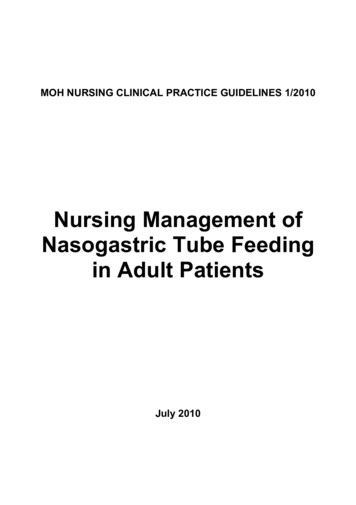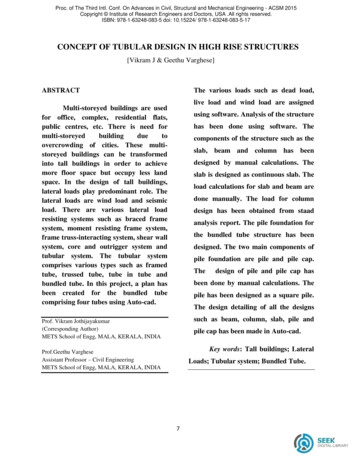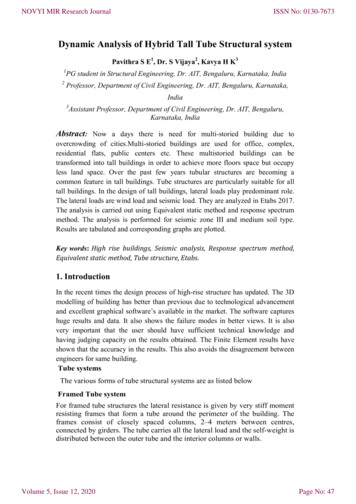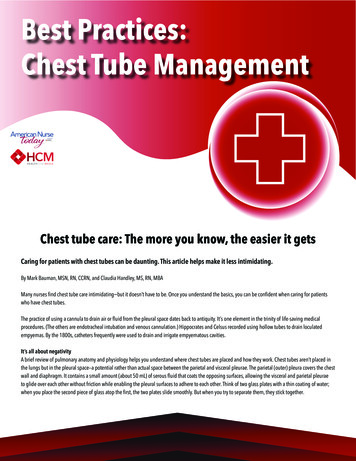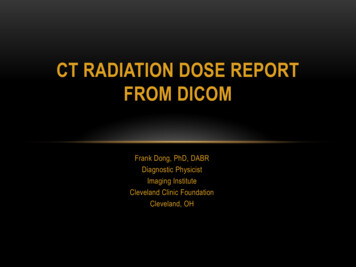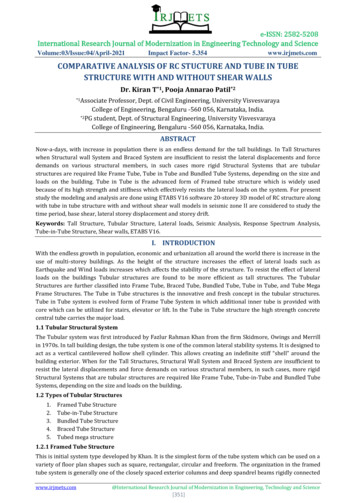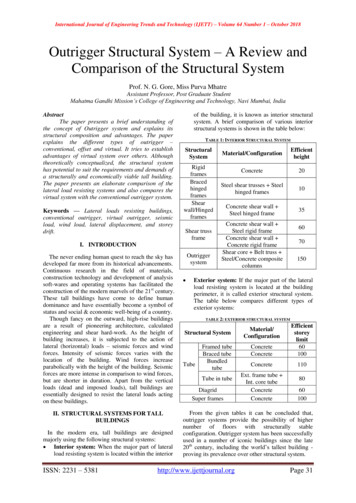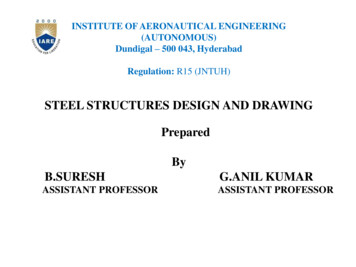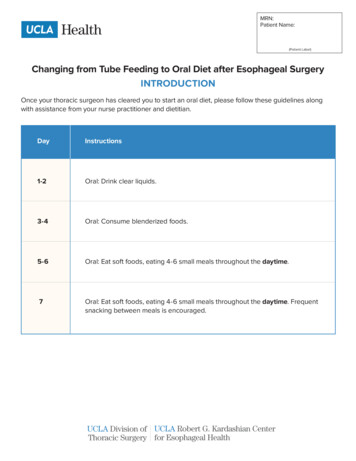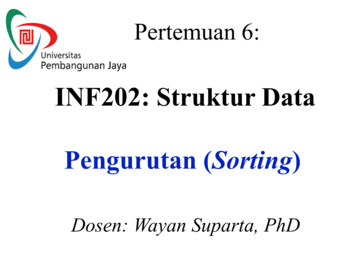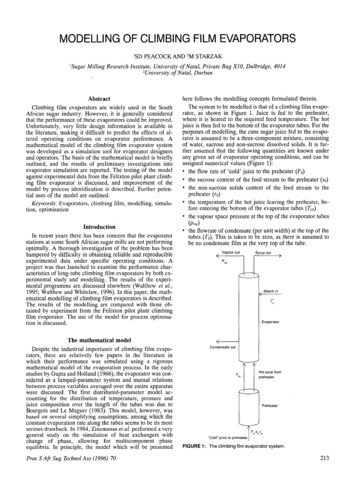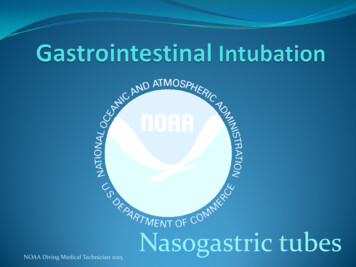
Transcription
NOAA Diving Medical Technician 2015Nasogastric tubes
Overview Types of Tubes Indications for their use How to insert NG tubes Complications of NG tubes Enteral Feedings Indications and Complications. Gastrostomy
Types of Tubes Short tubes: passed through the nose into the stomach Levin tube: range in size from 14 to 18 Fr, single lumenmade of plastic or rubber with holes near the tip. Gastric Sump (Salem): is radiopaque, clear plasticdouble lumen
Types Cont. Medium Tubes: tubes are passed through the nose tothe duodenum and the jejunum. Used for feeding Polyurethane or silicone rubber feeding tubes have anarrower diameter (6 to 12fr) and require the use of astylet for insertion Long tubes: passed through the nose, through theesophagus and stomach into the intestines. Used fordecompression of the intestines.
Example of Salem Sump
Indications for GI Intubation To decompress the stomach and remove gas andfluid To lavage the stomach and remove ingested toxins To diagnose disorders of GI motility and otherdisorders To administer medications and feedings To treat an obstruction To compress a bleeding site To aspirate gastric contents for analysis
Intubating the client with an NGtube Assessment: Who needs an NG: Surgical clientsVentilated clientNeuromuscular impairment .Clients who are unable to maintain adequate oralintake to meet metabolic demands. Assess patency of nares.
Assessment cont. Assess client’s medical history: Nosebleeds Nasal surgery Deviated septum Anticoagulation therapy Assess client’s gag reflex. Assess client’s mental status. Assess bowel sounds.
Planning Gather equipment: 14 0r 16 Fr NG tube Lubricating jelly PH test strips Tongue blade Flashlight Emesis basin Catheter tipped syringe 1 inch wide tape or commercial fixation device Suctioning available and ready
Planning Cont. Explain procedure to client Position the client in a sitting or high fowlersposition. If comatose-semi fowlers. Examine feeding tube for flaws. Determine the length of tube to be inserted. Measure distance from the tip of the nose to theearlobe and to the xyphoid process of thesternum. Prepare NG tube for insertion.
Measurement
Implementation Wash Hands Put on clean gloves Lubricate the tube Hand the client a glass of water Gently insert tube through nostril to back ofthroat (posterior nasopharnyx). Aim back anddown toward the ear. Have client flex head toward chest after tube haspassed through nasopharynx
Implementation Cont. Emphasize the need to mouth breathe and swallow during the procedure.Swallowing facilitates the passage of the tube through theoropharnyx.When the tip of the tube reaches the carnia stop and listenfor air exchange from the distal end of the tube. If air isheard remove the tube.Advance tube each time client swallows until desiredlength has been reached.Do not force tube. If resistance is met or client starts tocough, choke or become cyanotic stop advancing the tubeand pull back.
Implenentation Cont. Check placement of the tube. X-ray confirmation Testing pH of aspirate Secure the tube with tape or commercial device
NG Tube Insertion
Nasogastric Tube Position
Evaluation Observe client to determine response toprocedure. ALERTS!!! Persistent gagging – prolongedintubation and stimulation of the gag reflex canresult in vomiting and aspiration Coughing may indicate presence of tube in the airway.
Evaluation Cont. Note location of external site marking on the tube Documentation Size of tube, which nostril and client’s response. Record length of tube from the nostril to end oftube Record aspirate pH and characteristics
X-ray of misplaced NG tube
Testing Placement Wash hands and put on clean gloves Draw up 30cc of air into the syringe and attach to end ofthe NG tube. Flush tube with 30cc of air prior toattempting to aspirate fluid. Draw back on the syringe toobtain 5 to 10 cc of gastric aspirate. If unable to aspirate: Advance tube – may be in air space above aspirate level If intestinal placement suspected (pH 4-6) withdraw tube 5 to 10cm Have client lie on his/her left side wait 10-15 mins and attemptaspiration again.
Testing Placement cont. Observe appearance of aspirate: From client with enteral feeding – appearance ofcurdled enteral feedFrom nasointestinal – bile stainedFrom stomach (non feed)– green, tan, bloody, brown.Pleural fluid – pale yellow and serousGently mix aspirate in syringe
Testing Placement cont. Note: In a study by Metheny et al (1994)the gastric aspirate of 880 clients wereexamined: gastric aspirate ranged in color from green toyellow, tan/brown or bloody respiratory aspirate was described as tan oryellow/green (Best 2005)
Testing Placement Cont.Measure pH of aspirated GI contents by dipping pHstrip into the fluid or by applying a few drops ofthe fluid to the strip. Compare the color of thestrip with the color on the chart. Gastric fluid from a client who has fasted for atleast 4 hours usually has a pH range from 1 to 4but may be increased if the client is receiving acidinhibiting medications (pH 4-6)
Testing Placement Cont. Fluid from nasointestinal tube of fasting client usuallyhas a pH greater than 6. intestinal contents are lessacidic than stomach. Clients with a continuous tube feed may have a pH of 5or higher. Pleural fluid from the tracheubronchial tree isgenerally greater than 7. National Patient Safety Association(2005a)recommend a pH of less than 5.5 feedings can beinitiated (Best, 2005)
Testing Placement Cont. Measure the length of the tube from nostril to tip. If after repeated attempts, it is not possible toaspirate fluid from a tube that was originallyestablished by x-ray examination to be in thedesired position and there are NO risk factors fordislocation, tube has remained in original positionand the client is NOT experiencing any difficultyyou may assume the tube is correctly placed.
Responsibilities Identify signs and symptoms of inadvertentrespiratory migration. Identify conditions that increase the risk forspontaneous tube dislocation from the intendedposition (retching, vomiting, nasotrachealsuctioning, severe coughing)
Enteral Nutrition What is it: The administration of nutrients directly into theGI tract. The most desirable and appropriatemethod of providing nutrition is the oral route,but this is not always possible. Nasogastric feeding is the most common route Nurses are the main healthcare professionalresponsible for intubation
Questions?
Implementation Cont. Emphasize the need to mouth breathe and swallow during the procedure. Swallowing facilitates the passage of the tube through the oropharnyx. When the tip of the tube reaches the carnia stop and listen for air exchange from the distal end of the tube. If air is heard remove the tube. Advance tube each time client swallows until desired
